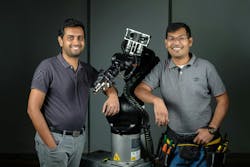Machine Vision Experts Develop a Visual Object Intelligence Platform
Gokul NA, co-founder of vision systems startup CynLr, was among a curated group of machine vision experts invited to be interviewed for Machine Design’s week of dedicated content on machine vision systems.
In a four-part video series, NA unpacked significant opportunities and threats for the manufacturing industry, all the while making a case for his company’s innovative machine vision solution, a computer vision and AI guided camera module designed for making industrial robot arms more versatile.
Speaking to Machine Design from Bangalore, India, NA revealed the backstory to the technology company he co-founded with CynLr’s CEO, Nikhil Ramaswamy.
CynLr is short for Cybernetics Laboratories. Formed in 2019 with the goal of specializing in visual object intelligence robotics and cybernetics, the company’s primary focus is to address the global challenge of part-mating and assembly automation.
To date, CynLr has developed smart technologies for comprehending, grasping and manipulating objects in unpredicted environments, said NA. The technology is currently in beta testing stage, with deployments at Denso and GM. CynLr also reported that it is engaging globally with automotive manufacturers, as well as a part supplier from Europe.
Building a Career in Solving Machine Vision Problems
The founders noted that they started working together at National Instruments (NI) as application engineers about 10 years ago. They have since been on a journey to solve the problem of “making machines see the way humans do.”
NA architected more than 40 vision systems at NI and trained more than 50 vision engineers for customers. Ramaswamy, who came up through the sales channel, similarly nurtured his strategic knowledge for emerging technologies such as machine vision, robotics, cyber physical systems and industrial automation.
Leveraging their combined strengths, the pair ventured out on their own around 2015 to finesse their technical approach to “vision for object manipulation.”
Extending the Machine Vision Market with a Visual Manipulation Robot Platform
According to NA, companies focusing on machine vision predominantly focus on one area, such as optical code-reading (barcodes) as their bigger market. He had realized early on that the applications of machine vision had been largely limited to identifying objects. This presented the opportunity to tackle some of the limitations.
The partners consulted for three years with companies on unsolved problems and rolled out 30 different deployments across multiple countries with a 100% success rate. “Every one of them had previously unsolved problems,” said NA. “And that was the only thing that customers were willing to give us.”
That experience laid a foundation for an architecture and an approach towards solving manipulation problems, NA said, and the impetus to “productize” their visual intelligence stack.
The culmination of this work is paying off with the launch of CynLr’s first commercial product, a general-purpose, visual manipulation robot platform that is powered by CynLr’s proprietary vision AI stack. CyRo is a dual-arm vision-guided robotic manipulator that can intuitively grasp objects, explained NA, and was on display at the Robotics Summit & Expo in Boston.
CynLr sources its components from more than 30 countries of origin. Manufacturing, warehousing and electronics assembly are big adopters of machine vision solutions, and CynLr noted that their technology would also be applicable to Advanced Driver Assistance Systems (ADAS) use cases.
Last year, the company announced the opening of a 13,000 sq. ft. research and development hub in Bengaluru. Known as Cybernetics H.I.V.E, the facility features 16 robot research cells that can accommodate 25 advanced robots.
Watch additional parts of this interview series with Gokul NA:
Editor’s Note: Machine Design’s WISE (Workers in Science and Engineering) hub compiles our coverage of workplace issues affecting the engineering field, in addition to contributions from equity seeking groups and subject matter experts within various subdisciplines.
About the Author

Rehana Begg
Editor-in-Chief, Machine Design
As Machine Design’s content lead, Rehana Begg is tasked with elevating the voice of the design and multi-disciplinary engineer in the face of digital transformation and engineering innovation. Begg has more than 24 years of editorial experience and has spent the past decade in the trenches of industrial manufacturing, focusing on new technologies, manufacturing innovation and business. Her B2B career has taken her from corporate boardrooms to plant floors and underground mining stopes, covering everything from automation & IIoT, robotics, mechanical design and additive manufacturing to plant operations, maintenance, reliability and continuous improvement. Begg holds an MBA, a Master of Journalism degree, and a BA (Hons.) in Political Science. She is committed to lifelong learning and feeds her passion for innovation in publishing, transparent science and clear communication by attending relevant conferences and seminars/workshops.
Follow Rehana Begg via the following social media handles:
X: @rehanabegg
LinkedIn: @rehanabegg and @MachineDesign

